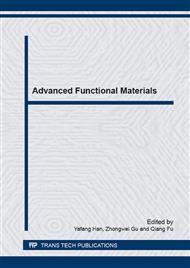[1]
R.M. Pilliar, P/M processing of surgical implants: Sintered porous surfaces for tissue-to-implant fixation, Int. J. Powder Metall. 34 (1998) 33-45.
Google Scholar
[2]
R. Mengel, C. Meer L.F. Jacoby, The treatment of uncoated and titanium nitride-coated abutments with different instruments, Int. J. Oral Maxillofac. Implants. 19 (2004) 232-238.
Google Scholar
[3]
T. Sawase, K. Yoshida, Y. Taira, K. Kamada, M. Atsuta,K. Baba, Abrasion resistance of titanium nitride coatings formed on titanium by ion-beam-assisted deposition, J. Oral Rehabil. 32 (2005) 151-157.
DOI: 10.1111/j.1365-2842.2004.01382.x
Google Scholar
[4]
B. Klinge, M. Hultin,T. Berglundh, Peri-implantitis, Dent. Clin. North Am. 49 (2005) 661-676, vii-viii.
DOI: 10.1016/j.cden.2005.03.007
Google Scholar
[5]
J. Lindhe, T. Berglundh, I. Ericsson, B. Liljenberg,C. Marinello, Experimental breakdown of peri-implant and periodontal tissues. A study in the beagle dog, Clin. Oral Implants Res. 3 (1992) 9-16.
DOI: 10.1034/j.1600-0501.1992.030102.x
Google Scholar
[6]
E.S.M. Ong, H.N. Newman, M. Wilson J.S. Bulman, The Occurrence of Periodontitis-Related Microorganisms in Relation to Titanium Implants, J. Periodontol. 63 (1992) 200-205.
DOI: 10.1902/jop.1992.63.3.200
Google Scholar
[7]
A. Ruhling, T. Kocher, J. Kreusch H.C. Plagmann, Treatment of subgingival implant surfaces with Teflon-coated sonic and ultrasonic scaler tips and various implant curettes. An in vitro study, Clin. Oral Implants Res. 5 (1994) 19-29.
DOI: 10.1034/j.1600-0501.1994.050103.x
Google Scholar
[8]
Y. Tamura, A. Yokoyama, F. Watari,T. Kawasaki, Surface properties and biocompatibility of nitrided titanium for abrasion resistant implant materials, Dent. Mater. J. 21 (2002) 355-372.
DOI: 10.4012/dmj.21.355
Google Scholar
[9]
I. Abrahamsson, T. Berglundh, J. Wennstrom,J. Lindhe, The peri-implant hard and soft tissues at different implant systems - A comparative study in the dog, Clin. Oral Implants Res. 7 (1996) 212-219.
DOI: 10.1034/j.1600-0501.1996.070303.x
Google Scholar
[10]
T. Berglundh, I. Abrahamsson, M. Welander, N.P. Lang,J. Lindhe, Morphogenesis of the peri-implant mucosa: an experimental study in dogs, Clin. Oral Implants Res. 18 (2007) 1-8.
DOI: 10.1111/j.1600-0501.2006.01380.x
Google Scholar
[11]
X. Shi, K. Tsuru, L. Xu, G. Kawachi,K. Ishikawa, Effects of solution pH on the structure and biocompatibility of Mg-containing TiO2 layer fabricated on titanium by hydrothermal treatment, Appl. Surf. Sci. 270 (2013) 445-451.
DOI: 10.1016/j.apsusc.2013.01.046
Google Scholar
[12]
X. Shi, M. Nakagawa, G. Kawachi, L. Xu,K. Ishikawa, Surface modification of titanium by hydrothermal treatment in Mg-containing solution and early osteoblast responses, J. Mater. Sci. Mater. Med. 23 (2012) 1281-1290.
DOI: 10.1007/s10856-012-4596-4
Google Scholar
[13]
X.L. Shi, K. Tsuru, G. Kawachi,K. Ishikawa, Effects of hydrothermal treatment on properties of titanium nitride coating for dental implants, Key Eng. Mater. 529-530 (2013) 247-250.
DOI: 10.4028/www.scientific.net/kem.529-530.247
Google Scholar
[14]
H. Aita, N. Hori, M. Takeuchi, T. Suzuki, M. Yamada, M. Anpo,T. Ogawa, The effect of ultraviolet functionalization of titanium on integration with bone, Biomaterials. 30 (2009) 1015-1025.
DOI: 10.1016/j.biomaterials.2008.11.004
Google Scholar
[15]
D. Scharnweber, F. Schlottig, S. Oswald, K. Becker,H. Worch, How is wettability of titanium surfaces influenced by their preparation and storage conditions?, J Mater Sci-Mater M. 21 (2010) 525-532.
DOI: 10.1007/s10856-009-3908-9
Google Scholar
[16]
S.M. Yang, H.Z. Kou, H.J. Wang, K. Cheng J.C. Wang, The photoelectrochemical properties of N3 sensitized CaTiO3 modified TiO2 nanocrystalline electrodes, Electrochim. Acta. 55 (2009) 305-310.
DOI: 10.1016/j.electacta.2009.08.055
Google Scholar
[17]
Y. Tsutsumi, D. Nishimura, H. Doi, N. Nomura,T. Hanawa, Difference in surface reactions between titanium and zirconium in Hanks' solution to elucidate mechanism of calcium phosphate formation on titanium using XPS and cathodic polarization, Mat. Sci. Eng. C-Bio. S. 29 (2009).
DOI: 10.1016/j.msec.2009.01.016
Google Scholar
[18]
H. Okawachi, Y. Ayukawa, I. Atsuta, A. Furuhashi, M. Sakaguchi, K. Yamane,K. Koyano, Effect of titanium surface calcium and magnesium on adhesive activity of epithelial-like cells and fibroblasts, Biointerphases. 7 (2012) 27.
DOI: 10.1007/s13758-012-0027-9
Google Scholar


